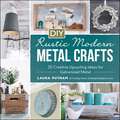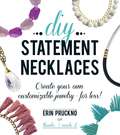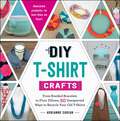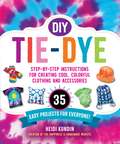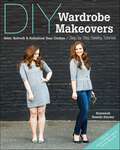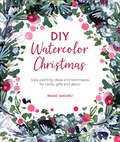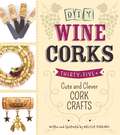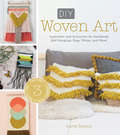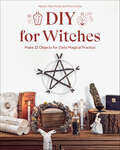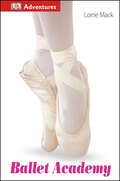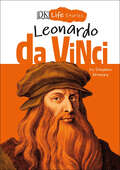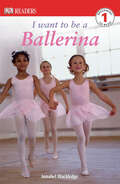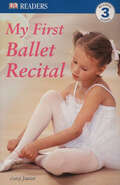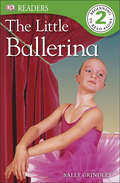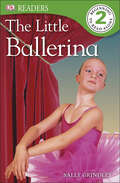- Table View
- List View
DIY Rustic Modern Metal Crafts: 35 Creative Upcycling Ideas for Galvanized Metal
by Laura PutnamTurn galvanized metal into stunning home decor!With this guide, you can finally get the rustic style you love--without having to spend a fortune! Filled with 35 creative ideas, you will learn how to use galvanized metal in a variety of projects, from stunning wall art to whimsical garden planters. Best of all, each page provides clear, step-by-step instructions, allowing anyone to repurpose galvanized sheets and containers into gorgeous home decor pieces like:Galvanized Leaf WreathVintage Window Memo BoardCandle LuminariesCoffee Table on CastersThree-Tiered Outdoor PlanterComplete with beautiful photographs and plenty of inspiration, DIY Rustic Modern Metal Crafts shows you how to transform your entire space with the charm and simplicity of your favorite look.
DIY Stamped Metal Jewelry: From Monogrammed Pendants to Embossed Bracelets--30 Easy Jewelry Pieces from HappyHourProjects.com!
by Adrianne SurianCreate beautiful, wearable works of art! With step-by-step instructions and photographs for thirty one-of-a-kind pieces, DIY Stamped Metal Jewelry shows you how easily you can make your own beautiful and creative stamped-metal accessories. All you need are some easy-to-find basic tools, various metals, and a few simple techniques. Adrianne Surian, creator of HappyHourProjects.com, presents illustrated instructions for easy, stunning designs, from customizable friendship bracelets to layered necklaces to rings for every mood. Stamped jewelry fits every wardrobe and every style, because it's an expression of you!
DIY Stamped Metal Jewelry: From Monogrammed Pendants to Embossed Bracelets--30 Easy Jewelry Pieces from HappyHourProjects.com!
by Adrianne SurianCreate beautiful, wearable works of art! With step-by-step instructions and photographs for thirty one-of-a-kind pieces, DIY Stamped Metal Jewelry shows you how easily you can make your own beautiful and creative stamped-metal accessories. All you need are some easy-to-find basic tools, various metals, and a few simple techniques. Adrianne Surian, creator of HappyHourProjects.com, presents illustrated instructions for easy, stunning designs, from customizable friendship bracelets to layered necklaces to rings for every mood. Stamped jewelry fits every wardrobe and every style, because it's an expression of you!
DIY Statement Necklaces
by Erin PrucknoIt's time to make a statement with these stylish necklaces! Stand out from the crowd with the beautifully bold jewelry in DIY Statement Necklaces! Featuring step-by-step instructions and photographs for 35 one-of-a-kind necklaces, this jewelry guide shows you how to transform your entire wardrobe--without spending a fortune. Best of all, each chapter includes quick tutorials on how to customize jewelry materials to create eye-catching statement necklaces that reflect your taste and style. Whether you're looking to brighten up your everyday attire or sparkle in your little black dress, DIY Statement Necklaces helps you craft striking, designer-inspired jewelry without breaking the bank.
DIY Statement Necklaces: Create Your Own Customizable Jewelry--For Less!
by Erin PrucknoIt's time to make a statement with these stylish necklaces!Stand out from the crowd with the beautifully bold jewelry in DIY Statement Necklaces! Featuring step-by-step instructions and photographs for 35 one-of-a-kind necklaces, this jewelry guide shows you how to transform your entire wardrobe--without spending a fortune. Best of all, each chapter includes quick tutorials on how to customize jewelry materials to create eye-catching statement necklaces that reflect your taste and style.Whether you're looking to brighten up your everyday attire or sparkle in your little black dress, DIY Statement Necklaces helps you craft striking, designer-inspired jewelry without breaking the bank.
DIY String Art: 24 Designs to Create and Hang
by Jesse DresbachThis isn't your summer camp string art! String art is making a comeback with seemingly endless new designs, and author Jesse Drebach's modern, more flexible approach lets you methodically string away to your heart's content. This book is full of patterns--simple to more intricate designs--that help you quickly get to the fun part of the craft--the stringing! Jesse walks you through his tool room, and even includes tips on cutting and preparing the right size boards. He shares how to structure the nails using paper patterns and details several stringing techniques.DIY String Art includes simple geometrics, nature-inspired motifs worked on tree slices, zodiac signs, and even patterns for negative space string art where you fill in the entire board everywhere but inside the chosen motif. These are cool, urban designs, some with random string work, some with faceted sections and still others with specific string paths to achieve more uniform results, and they look amazing no matter where you hang them. Jesse's double-wrap technique lets you add pronounced details and even create a string frame--he's thought of, basically, everything you need to know to string a gallery of modern art!
DIY Succulents: From Placecards to Wreaths, 35+ Ideas for Creative Projects with Succulents
by Tawni DaigleAs featured in The Washington Post Dig into dozens of stunning succulent creations!Go beyond the garden to create succulent projects that take center stage in any space. DIY Succulents shows you how to use beautiful and resilient plants like echeveria, sedum, and graptopetalum to craft nature-inspired home decor like rustic tabletop centerpieces and breathtaking wall art. Each page offers details on selecting the right plants and containers for the project, assembling a gorgeous arrangement, and maintaining the garden as it grows. With step-by-step instructions, gardening tips, and dozens of ideas to choose from, anyone can create imaginative succulent crafts like:Living WreathBirch Log PlanterTerrarium NecklaceTopiary BallComplete with photos and plenty of inspiration, DIY Succulents will help you add creativity, color, and personality to every room in your home.
DIY T-Shirt Crafts
by Adrianne SurianTransform old T-shirts into trendy accessories--in 60 minutes or fewer!Creating something useful and stylish doesn't have to take ages or require expensive supplies. From an Easy Twisted Headband to Round Lounge Pillows, DIY T-Shirt Crafts teaches you how to repurpose old T-shirts into 50 beautiful projects worthy of showing off. Complete with step-by-step instructions and stunning photographs, each T-shirt craft is simple enough for beginners to recreate and can be finished in 60 minutes or fewer. Guided by Adrianne Surian, the crafter behind the popular blog Happyhourprojects.com, you'll turn this wardrobe staple into trendy, one-of-a-kind accessories, including:Ruffled Rosette Hair BarretteBraided Chain Statement NecklaceFringed Infinity ScarfGalaxy Bleached No-Sew Tote BagAromatherapy Neck Pillow Whether you're cleaning out your closet, want to personalize your look, or just found a hole in your favorite top, it's time to take your tees to the next level with these fashion-forward projects!
DIY T-Shirt Crafts: From Braided Bracelets to Floor Pillows, 50 Unexpected Ways to Recycle Your Old T-Shirts
by Adrianne SurianTransform old T-shirts into trendy accessories--in 60 minutes or fewer!Creating something useful and stylish doesn't have to take ages or require expensive supplies. From an Easy Twisted Headband to Round Lounge Pillows, DIY T-Shirt Crafts teaches you how to repurpose old T-shirts into 50 beautiful projects worthy of showing off. Complete with step-by-step instructions and stunning photographs, each T-shirt craft is simple enough for beginners to recreate and can be finished in 60 minutes or fewer. Guided by Adrianne Surian, the crafter behind the popular blog Happyhourprojects.com, you'll turn this wardrobe staple into trendy, one-of-a-kind accessories, including:Ruffled Rosette Hair BarretteBraided Chain Statement NecklaceFringed Infinity ScarfGalaxy Bleached No-Sew Tote BagAromatherapy Neck Pillow Whether you're cleaning out your closet, want to personalize your look, or just found a hole in your favorite top, it's time to take your tees to the next level with these fashion-forward projects!
DIY Temporary Tattoo Art: Easy Step-by-Step Instructions for Watercolor, Henna, Flash Tattoos, and More!
by K. L. CaoA Simon & Schuster eBook. Simon & Schuster has a great book for every reader.
DIY Tie-Dye: Step-by-Step Instructions for Creating Cool, Colorful Clothing and Accessories—35 Easy Projects for Everyone!
by Heidi Kundin30 step-by-step tie-dye projects with full color photos perfect for crafting fun at home! Add bursts of color and creativity to your days with simply sensational tie-dye! With 30 fun projects to choose from, everyone will find something they love. You can master the classic tie-dye T-shirt but also go beyond the basic to discover new patterns, techniques, and possibilities for DIY clothing, accessories, and home decor. Step-by-step directions and full-color photos guide you to beautiful results with less mess. With this book, learn to make tie-dye:T-shirtsSkirtsDressesLeggingsSweatshirtsScarvesBaby onesiesBucket HatsHeadbands and ScrunchiesSocksShoesDrawstring BackpacksDog Collars and LeashesPillowsDuvet coversCurtainsTowelsGarden flagsAnd More!Get your best tie-dye results ever with expert tips on choosing dyes, perfecting patterns, and making colors last. DIY Tie-Dye fills the tie-dye process with ease, imagination, and enjoyment for all ages!
DIY Wardrobe Makeovers: Alter, Refresh & Refashion Your Clothes
by Suzannah Hamlin StanleyAffordable, stylish, and trendy refashions Unlock your closet’s potential with simple, stylish wardrobe refashions you can sew at home. DIY-style blogger Suzannah Hamlin Stanley provides her unique blend of basic alterations and step-by-step restyling tutorials to give you a wardrobe you’ll truly love! Express your style and save money by embellishing and combining garments into newfound faves. No sloppy shortcuts here—learn how to alter sweaters, pants, and everything in your wardrobe for a more flattering fit. Guidance on how to take it in, take it up, let it down, or let it out Sew easy alterations for a perfect fit, with step-by-step tutorials Spend less, look better! Create upcycled, eco-conscious, affordable fashions
DIY Watercolor Christmas: Easy painting ideas and techniques for cards, gifts and décor (Diy Watercolor Ser. #3)
by Ingrid SanchezMake the holidays the most artistic time of the year with this creative guide to painting festive ornaments, stockings, decorations, and more. Here you&’ll find a wealth of inspiration and techniques for all sorts of watercolor projects this Christmas! Starting with the materials and equipment you need for watercolor painting, you&’ll learn how to create both traditional and contemporary color palettes for Christmas and discover a wide range of watercolor techniques. Twelve creative projects follow, with easy-to-follow step-by-step tutorials so that even beginners to watercolor can jump right in. Learn how to paint your own Christmas cards, gift tags and gift boxes, create seasonal table settings, hand painted Christmas crackers and garlands, and unique hand-painted Christmas gifts including a watercolor wreath. This inspirational book will also show you how to use watercolor primer products to paint onto glass baubles, 3D cardboard letters, wooden tree ornaments and more. And once you have the skills, who knows where your imagination will take you? Finally, a gallery of additional Christmas motifs and designs that can be used for further inspiration can be found at the end of the book including reindeer, robins, mittens, snowflakes, stars, baubles, snowmen, candy canes, winter foliage, presents, decorations, elves and much much more! Artist Ingrid Sanchez, aka @creativeingrid, shares her beautiful artwork and expert guidance in this unique celebration of Christmas in watercolor.
DIY Wine Corks
by Melissa AverinosUncork stunning DIY projects! Pop open a bottle of wine! Break out your glue gun! DIY Wine Corks offers 35+ one-of-a-kind crafts of all varietals. Featuring easy-to-follow instructions and tips on personalizing your design, this book guides you through every step of your wine cork project, allowing you to create unique pieces every time. From wall art to jewelry to holiday decor, each of these crafts will put leftover wine corks to use by transforming the simple throwaway into stunning creations like: Chalkboard menu Retro sunburst mirror Vintage cork necklace Owl zipper pull Gift tags Complete with beautiful full-color photographs, DIY Wine Corks encourages you to stop and smell the rose with these creative wine cork crafts!
DIY Wine Corks: 35+ Cute and Clever Cork Crafts
by Melissa AverinosUncork stunning DIY projects!Pop open a bottle of wine! Break out your glue gun! DIY Wine Corks offers 35+ one-of-a-kind crafts of all varietals. Featuring easy-to-follow instructions and tips on personalizing your design, this book guides you through every step of your wine cork project, allowing you to create unique pieces every time. From wall art to jewelry to holiday decor, each of these crafts will put leftover wine corks to use by transforming the simple throwaway into stunning creations like:Chalkboard menuRetro sunburst mirrorVintage cork necklaceOwl zipper pullGift tags Complete with beautiful full-color photographs, DIY Wine Corks encourages you to stop and smell the rose with these creative wine cork crafts!
DIY Woven Art: Inspiration and Instruction for Handmade Wall Hangings, Rugs, Pillows and More!
by Rachel DenbowAn alt twist on traditional wall hangings! Get crafty with DIY Woven Art! These 14 fabulous fiber art projects--from colorful pillows and rugs to dramatic wall hangings--will add a pop to any room in your house. No loom? No worries. Rachel Denbow shows you how to fabricate 3 simple, portable looms.DIY Woven Art also includes tips on customizing your designs and choosing the right fibers and embellishments for each project--basically, everything you need to know to create these gorgeous projects from start to finish. Happy weaving!
DIY for Witches: Make 22 Objects for Daily Magical Practice
by Marine Nina Denis Flora DenisWitches and wizards begin your magical journey! Welcome to the world of witchcraft! When you practice magic, you must surround yourself with essential objects that will accompany you in everyday life, as well as in your work and rituals. The most effective tools will be those that you take the time to lovingly craft and truly bond with, right from the start. Create 22 magical objects to make for ritual, divination, at home, and on the go. These are easy-to-make tools you’ll turn to again and again in your magic works and your rituals from magic candles and fumigation sticks to runes and oracles and much more. Start practicing witchcraft with this step-by-step introduction that lovingly introduces the craft Create 22 magical objects for ritual, divination, at home, and on the go Includes resources on pagan festivals for rituals, list of magical powers of plants, the meaning of colors, magic signs and symbols, and moon phases
DK Adventures: Ballet Academy (DK Adventures)
by Lorrie MackLucy follows her dream to train to be a professional ballerina, and is selected as one of a handful of students into the Ballet Academy. Follow her journey as she gets through the tough training with the support of teachers and fellow students, and performs alongside her idol in The Nutcracker before facing her final challenge of getting into Ballet High School. DK Adventures are an innovative mix of narrative and nonfiction for kids ages 8-11 featuring engaging, action-packed stories that help kids build their skills in vocabulary, grammar, comprehension, and critical thinking while developing a love of reading. With diaries, recipes, poetry, instructions, graphics, or songs, the genre spreads in each DK Adventures title enhance the story and reinforce curriculum learning, while the expansive range of entertaining nonfiction subjects will appeal to boys and girls everywhere. Supports the Common Core State Standards.
DK Life Stories: Leonardo da Vinci (DK Life Stories)
by Stephen KrenskyDiscover the inspiring story of Leonardo da Vinci, the artist, inventor, and engineer of the Italian Renaissance...Leonardo was a creative genius who wanted to understand how things worked. This book traces his life, from his birth in a hilltop village near Florence, Italy, through to his work as a painter, sculptor, and engineer. Leonardo made hundreds of drawings and paintings, including the Mona Lisa - probably the most famous painting in the world. Learn how Leonardo made detailed sketches of the human body and designs of parachutes, helicopters, and armored tanks - many years before the technology existed to build them.This new kids' biography series from DK goes beyond the basic facts to tell the true life stories of history's most interesting and inspiring people. Full-color photographs and hand-drawn illustrations complement age-appropriate narrative text to create an engaging book children will enjoy reading. Definition boxes, information sidebars, inspiring quotes, and other nonfiction text features add depth, and a handy reference section at the back makes DK Life Stories the one biography series everyone will want to collect.
DK Readers L1: I Want to Be a Ballerina (DK Readers Level 1)
by Annabel BlackledgeThe perfect beginner's book for aspiring ballerinas. Join Jamie and her friends at their first-ever ballet lesson. Watch Jamie as she learns to dance and makes new friends. Young readers will discover the importance of patience, kindness, and believing in themselves. Stunning photographs combine with lively illustrations and engaging, age-appropriate stories in DK Readers, a multilevel reading program guaranteed to capture children's interest while developing their reading skills and general knowledge. With DK Readers, children will learn to read—then read to learn!
DK Readers L1: I Want to Be a Ballerina (DK Readers Level 1)
by Annabel BlackledgeThe perfect beginner's book for aspiring ballerinas. Join Jamie and her friends at their first-ever ballet lesson. Watch Jamie as she learns to dance and makes new friends. Young readers will discover the importance of patience, kindness, and believing in themselves. Stunning photographs combine with lively illustrations and engaging, age-appropriate stories in DK Readers, a multilevel reading program guaranteed to capture children's interest while developing their reading skills and general knowledge. With DK Readers, children will learn to read—then read to learn!
DK Readers: My First Ballet Recital (DK Readers Level 3)
by DK Amy JunorThe DK Reader My First Ballet Recital is the story of a girl's preparation for her first ballet performance, where she and her classmates can show off all they've learned! Packed with full-color photographs, lively illustrations, and engaging, age-appropriate stories to introduce young children to a life-long love of reading. These amazing stories are guaranteed to capture children's interest while developing their reading skills. Perfect for reading together! The playful images in this eBook are enhanced with entertaining animations and surprising sounds to bring this story to life.
DK Readers: My First Ballet Recital (DK Readers Level 3)
by DK Amy JunorThe DK Reader My First Ballet Recital is the story of a girl's preparation for her first ballet performance, where she and her classmates can show off all they've learned! Packed with full-color photographs, lively illustrations, and engaging, age-appropriate stories to introduce young children to a life-long love of reading. These amazing stories are guaranteed to capture children's interest while developing their reading skills. Perfect for reading together!
DK Readers: The Little Ballerina (DK Readers Level 2)
by Sally GrindleyIt's the day of the big show at Laura's ballet school. Suddenly, disaster strikes! Can Laura help save the show?Stunning photographs combine with lively illustrations and engaging, age-appropriate stories in DK Readers, a multilevel reading program guaranteed to capture children's interest while developing their reading skills and general knowledge. With DK Readers, children will learn to read—then read to learn!
DK Readers: The Little Ballerina (DK Readers Level 2)
by Sally GrindleyIt's the day of the big show at Laura's ballet school. Suddenly, disaster strikes! Can Laura help save the show?Stunning photographs combine with lively illustrations and engaging, age-appropriate stories in DK Readers, a multilevel reading program guaranteed to capture children's interest while developing their reading skills and general knowledge. With DK Readers, children will learn to read—then read to learn!
